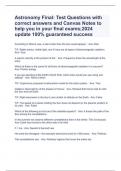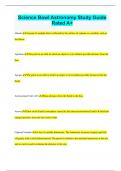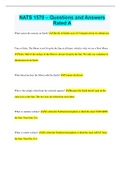Eclipses Study guides, Class notes & Summaries
Looking for the best study guides, study notes and summaries about Eclipses? On this page you'll find 111 study documents about Eclipses.
Page 3 out of 111 results
Sort by

-
ASTR Exam 2024 with 100% correct answers
- Exam (elaborations) • 4 pages • 2024
-
- $14.49
- + learn more
On oct 14, NYC will see the sun eclipsed about ____ % _____ than Burlington - correct answer 6, more Because of the moons eccentric orbit, the maximum change in its apparent diameter is closest to ____ % - correct answer 10 The sun usually looks redder at sunset than at midday because ____ - correct answer you're looking through a longer path of atmosphere at sunset than at midday Annular solar eclipses cannot be seen - correct answer when the moon is near its perigee On average, th...

-
PHY-105 Creighton University Exam All Possible Questions and Answers with complete solution
- Exam (elaborations) • 3 pages • 2024
- Available in package deal
-
- $9.69
- + learn more
PHY-105 Creighton University Moon - an object which orbits a planet Asteroid - small rocky object which orbits a star Comet - small icy object which orbits a star Planet - large object in space that orbits a star and does not produce light of its own (reflected light) Solar System - a star and all the materials which orbit it - planets and moons Star - a giant ball of hot gas (ranges in color and sizes) Nebula - a large cloud of dust and gas in space Galaxy - a great island of stars in ...

-
Astronomy Final: Test Questions with correct answers and Canvas Notes to help you in your final exams;2024 update 100% guaranteed success
- Exam (elaborations) • 8 pages • 2024
-
- $14.99
- + learn more
Astronomy Final: Test Questions with correct answers and Canvas Notes to help you in your final exams;2024 update 100% guaranteed success According to Wien's Law, a star cooler than the Sun would appear: Ans- Red T/F: Radio waves, visible light, and X-rays are all types of electromagnetic radiation. Ans- True A wave's velocity is the product of the: Ans- Frequency times the wavelength of the wave Which of these is the same for all forms of electromagnetic radiation in a vac...

-
NYSTCE CST Multisubject Part 3 245 Training Exam And 100% Correct Answers 2024.
- Exam (elaborations) • 9 pages • 2024
- Available in package deal
-
- $9.99
- + learn more
Scientific Inquiry - Answer The diverse ways in which scientists study the natural world and propose explanations based on the evidence derived from their work. Features of Scientific Inquiry - Answer 1. Learner engages in scientifically oriented questions 2. Learner gives priority to evidence in responding to questions 3. Learner formulates explanations from evidence 4. Learner connects explanations to scientific knowledge 5. Learner communicates and justifies explanations Steps o...

-
CAP Aerospace Mitchell Test | 75 Questions with 100% Correct Answers | Verified | Latest Update 2024
- Exam (elaborations) • 7 pages • 2023
- Available in package deal
-
- $10.49
- + learn more
Which of the following is NOT a real danger for low ear orbiting satellites? - Volcanic Eruptions What is the goal of NASA? - Peaceful exploration of space for the benefit of all humankind Who discovered the relationship between pressure and fluids in motion that became the cornerstone of the theory of aerofoil lift? - Daniel Bernoulli In what year did communication satellites begin? - 1964 What is the most important element of our solar system? - the Sun Which of the following is not true...

-
Science Bowl Astronomy Study Guide Rated A+
- Exam (elaborations) • 6 pages • 2024
- Available in package deal
-
- $8.99
- + learn more
Science Bowl Astronomy Study Guide Rated A+ Albedo Amount of sunlight that is reflected by the surface of a planet or a satellite, such as the Moon. Aphelion The point in an orbit in which an object is at its farthest possible distance from the Sun. Apogee The point in an orbit in which an object is at its farthest possible distance from the Earth. Astronomical Unit (AU) Mean distance from the Earth to the Sun. Aurora Glow in the Earth's ionosphere caused by the interaction...

-
NYSTCE CST MULTISUBJECT PART 3 (245)|UPDATED&VERIFIED|100% SOLVED|GUARANTEED SUCCESS
- Exam (elaborations) • 11 pages • 2023
- Available in package deal
-
- $16.99
- + learn more
Scientific Inquiry The diverse ways in which scientists study the natural world and propose explanations based on the evidence derived from their work. Features of Scientific Inquiry 1. Learner engages in scientifically oriented questions 2. Learner gives priority to evidence in responding to questions 3. Learner formulates explanations from evidence 4. Learner connects explanations to scientific knowledge 5. Learner communicates and justifies explanations Steps of Scientific...

-
NATS 1570 – Questions and Answers Rated A
- Exam (elaborations) • 4 pages • 2023
- Available in package deal
-
- $9.99
- + learn more
NATS 1570 – Questions and Answers Rated A What causes the seasons on Earth? The tilt of Earth's axis (23.5 degrees) from it's orbital axis True or False. The Moon is not lit up by the Sun at all times, which is why we see a New Moon. False. Half of the surface of the Moon is always lit up by the Sun. We only see variations of illumination from Earth. What direction does the Moon orbit the Earth? Counter-clockwise Why is the ecliptic tilted from the celestial equator? Because the Earth doe...

-
Astronomy 1010 Final Exam
- Exam (elaborations) • 11 pages • 2023
-
- $12.49
- + learn more
The constellations shift about 1o each day - Answer- True __________________ introduced the ellipse to explain the orbits of the planets. - Answer- Kepler Which of the following sentences is NOT true about science? - Answer- Science only progresses by following the scientific method Why does the phase of the moon change? - Answer- We see the illuminated part facing the sun. After the fall of the Roman Empire, scientific progress came to a halt in Europe. - Answer- False If a plane...

-
NATS 1570 exam 2023 with 100% correct answers
- Exam (elaborations) • 3 pages • 2023
- Available in package deal
-
- $13.49
- + learn more
What causes the seasons on Earth? The tilt of Earth's axis (23.5 degrees) from it's orbital axis True or False. The Moon is not lit up by the Sun at all times, which is why we see a New Moon. False. Half of the surface of the Moon is always lit up by the Sun. We only see variations of illumination from Earth. What direction does the Moon orbit the Earth? Counter-clockwise Why is the ecliptic tilted from the celestial equator? Because the Earth doesn't spin on the same...

That summary you just bought made someone very happy. Also get paid weekly? Sell your study resources on Stuvia! Discover all about earning on Stuvia


